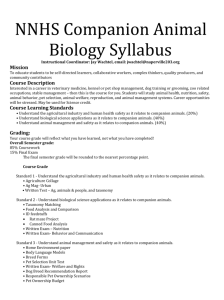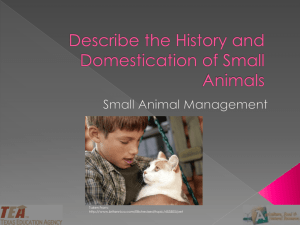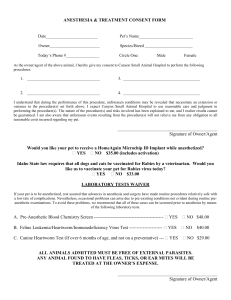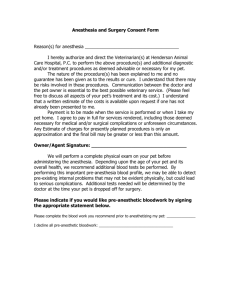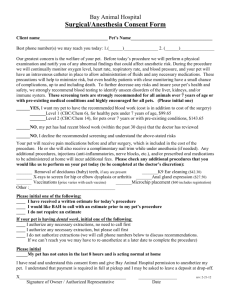Companion Animals in Modern Life
advertisement
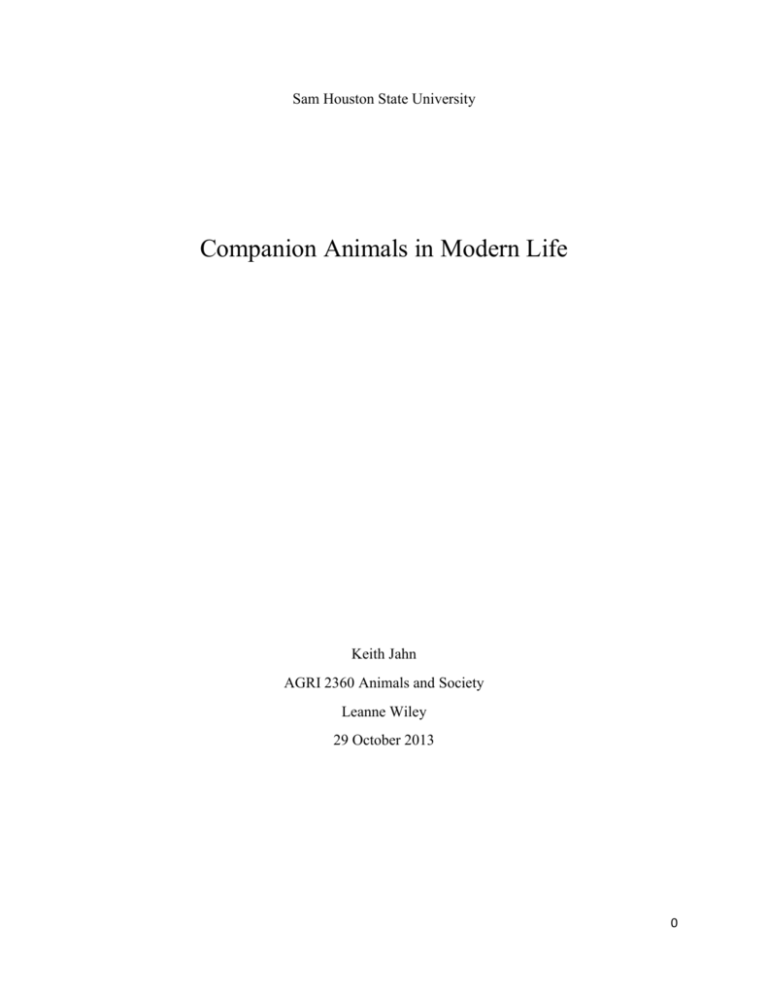
Sam Houston State University Companion Animals in Modern Life Keith Jahn AGRI 2360 Animals and Society Leanne Wiley 29 October 2013 0 Introduction In today’s world, animals play a very large role in the lives of most people, especially Americans. It is unlikely that an individual will not come into contact with animals in normal day to day life; they are everywhere. Animals are used for service, sport, recreation, and of course, they are a food source for the majority of Americans. While the majority of people in this country are not regularly involved in zoos or rodeos, and an even smaller percentage of Americans can say that they have visited a farm or ranch, there is one category of animal that the vast majority of people can relate to: companion animals. Studies show that over 60% of Americans own some kind of pet, and when added to the number of people that do not own a pet but regularly come into contact with someone else’s pet, the percentage grows even higher (APPA). Due to the immense popularity of companion animals, and the sheer number of these animals owned in the U.S., companion animal ownership has become a topic of debate. With so many companion animals out there it isn’t surprising that both benefits and problems have been observed. Figure 1. The Pros Evidence of humans domesticating and keeping animals as pets can be traced back to as early as 10000 BC (Express). Since that time, a number of perceived benefits have been observed, and the popularity of companion animals continues to grow. In addition to the obvious benefits of keeping a companion animal (companionship, entertainment, etc.), there are more advantages than people generally think about. Observation and scientific study has shown that animal ownership is associated with a range of physical, psychological, and social health advantages. 1 They physical benefits of owning a pet are simple, and directly related to the amount of activity in which an owner participates with his or her pet. Owners whose pets require daily exercise are likely to gain from this need of their pet. For instance, walking or running with a dog benefits both owner and animal. Figure 2. While the physical benefits are simple and easy to observe, the wide range of psychological effects of pet ownership are more complex, yet just as beneficial. Animals have been used in therapy for over 200 years, and today, the number of animals used in treatment continues to grow (Behling 109). Studies have shown that both scheduled and unscheduled interaction with animals is beneficial to the institutionalized elderly. Animal visits and programs in long term care facilities for the elderly have shown to improve the overall morale within the facilities, for both residents and staff. In addition to programs within care facilities, research has shown that animal interaction in the homes of elderly people living alone provides a level of companionship that can prevent depression. In addition to the therapeutic benefit to the elderly, animals are regularly used in clinical situations with young patients having conditions such as autism. In clinical settings, children with autism are often distressed, and the presence of a companion animal in the patient room has been found to reduce procedure-induced anxiety in patients (Bradley 4). Animal therapy is also used outside of the clinical setting to benefit those with autism. Such therapy helps children with autism become more physically developed and improve their strength, coordination, and physical abilities. Studies have also shown that the presence of companion animals benefits cognitive and language development in all children (Risley-Curtiss 38). Figure 3. 2 The Cons With so many Americans owning pets, and with so many animals in the country, some prominent issues have become apparent. Pet owners must carry out their responsibilities correctly by feeding the animals under their care with proper food, exercising them and guaranteeing they get medical treatment as well as the essential annual vaccinations. While the majority of pet owners are responsible in taking care of their pets, others are not. This is where the problems arise. Many owners find that they can no longer properly care for their pets, so they release them into cities and into the wild. An estimated 5 to 7 million companion animals enter animal shelters nationwide every year, and 3 to 4 million dogs and cats are euthanized each year due to shelters being too full and a lack adoptive homes. To make matters worse, the majority of these stray animals aren’t spayed or neutered, and their numbers continue to rise. To combat the rising number of stray animals on the street, organizations across the country urge pet owners to get their animals fixed. Also contributing to the problem of stray animals is the fact that few people are interested in adopting animals, and would rather purchase a young animal from a breeder or pet store. With very few of these animals getting taken off the street, and even fewer of these animals getting adopted, the problem of stray pets is continually getting worse. Figure 4. The Humane Society of the United States The Humane Society of the United States, or HSUS, is an organization that stands to correct the problem of strays animals, as well as other issues surrounding companion animals. While the HSUS is not against the idea of companion animals, they campaign heavily on animal spay and neutering as well as pet adoption campaigns. The HSUS’s animal rescue program gets stray animals off the street, gets them rehabilitated, and puts those animals up for adoption. Due to the vast numbers of animals available for adoption, the HSUS is against purchasing animals at pet stores. As well as stray rescue, the HSUS has programs that rescue animals after natural disasters all across the country. In addition to their adoption campaigns, HSUS fights to stop the production of animals in “puppy mills”, which only make the stray animal situation worse. Puppy mills are large-scale commercial breeding facilities that often neglect the essential health and welfare of the dogs in their care. It is estimated that at least 10,000 “puppy mills” are active 3 in the United States. The Humane Society tries to stop the mass breeding of pets in these mills, which in many cases, the animals coming from these operations are very ill when they reach pet stores. Another main objective of the Humane Society is stopping acts of animal cruelty such as dogfighting. Recently, in March of 2013, the HSUS participated in a dogfighting bust in Mississippi that led to the rescue of 20 dogs and arrest of numerous alleged dogfighters (HSUS). The Law With so many animals in the country, there are a many laws that regulate just about every aspect of companion animal ownership. From purchase and sale, to care and breeding, state and national law set guidelines that owners must follow. Perhaps some of the most important laws in place are the ones to combat the severe issues surrounding Figure 5. companion animals. Many states have put laws into effect to combat the rising stray population. Several states have created laws that put strict regulations on “puppy mills” by forcing breeders who sell or exchange 20 or more animals yearly to obtain a breeding license and undergo yearly inspection. Not only will these types of laws discourage average Americans from breeding large amounts of pets, having breeders submit to inspections will help reduce situations of animal cruelty and neglect in large scale breeding operations. Also, several states have created laws that require pet stores to post certain information about their puppies’ origins on each of their cages. This type of law is designed to give consumers more information about where the dogs were raised, and help them avoid buying puppies from “puppy mills” (HSUS). Although it has seen significant decline in recent years, dogfighting is one problem that lawmakers hope to eliminate with strict laws and regulations. In most states it is a felony to own, possess, train, transport or sell any dog for the intention of fighting. Areas with more instances of dogfighting are stepping up their laws to combat this issue. Georgia recently updated its dogfighting law, which sets a penalty of one to five years in prison or a minimum fine of $5,000 for first offenders, making it one of the strongest in the nation (Georgia). 4 News Promising signs that conditions and issues surrounding companion animals are getting better can be found in news stories across the nation. Bringing issues and violations to the knowledge of the public is perhaps the best way to combat violations on a large scale (Tiplady). Recently, and undercover investigation proved that nine out of the 12 pets stores in Maryland that sell puppies were found to be violating a Maryland law that requires stores to post background information about puppies’ origins on the cage of each animal. This law has been in affect for over a year, and is designed to protect buyers from purchasing an animal raised in a puppy mill that may be neglected and in poor health. In one of the stores violating the law, investigators found that not only was the documentation law being broken, some of the puppies were so ill and underweight that law enforcement was contacted immediately (HSUS). A large majority of the public simply doesn’t know laws like this one are being broken, because they don’t know they exist. Articles in the media like this one help spread the word and warn potential buyers for what to look for. Figure 6. Conclusion It is easy to see that most of Americans love animals. With so many pet owners out there, companion animals have become a part of normal American life. But, like anything else good, companion animals can be abused and neglected, and problems arise. Thanks to responsible pet owners, organizations like the HSUS, law enforcement, legislature, and the media, these problems that surround companion animals will continue to decline, conditions will improve, and the list of downsides to companion animal ownership will continue to shrink. 5 Works Cited “A Secret History of Pets: Why humans have kept animals as pets since ancient times”. Express. N.p. 25 July 2013. Web. 28 October 2013. Behling, Robert J., James Haefner, and Michael Stowe. "Animal Programs And Animal Assisted Therapy In Illinois Long-Term Care Facilities Twenty Years Later (1990-2010)." Academy Of Health Care Management Journal 7.2 (2011): 109-117. Business Source Complete. Web. 28 Oct. 2013. "Georgia dog fighting law gets harder bite.(Sonny Perdue revised and signed dog-fighting law)(Brief article)." American City & County 2008: Academic OneFile. Web. 29 Oct. 2013. Iannacone, Stephen. "Felony Animal Cruelty Laws In New York." Pace Law Review 31.2 (2011): 748770. Academic Search Complete. Web. 29 Oct. 2013. “Majority of Maryland Puppy-Selling Stores Found Violating Consumer Disclosure Law”. The Humane Society of the United States. N.p. 14 October 2013. Web. 28 October 2013. Pavlides, Merope. Animal-Assisted Interventions For Individuals With Autism. London: Jessica Kingsley Publishers, 2008. eBook Academic Collection (EBSCOhost). Web. 29 Oct. 2013. Risley-Curtiss, C. (2010). Social Work Practitioners and the Human--Companion Animal Bond: A National Study. Social Work, 55(1), 38-46. Smith, Bradley. "The 'Pet Effect': Health Related Aspects Of Companion Animal Ownership." Australian Family Physician 41.6 (2012): 439. Informit Health Collection. Web. 28 Oct. 2013. Tiplady, Catherine. Walsh, Deborah-Anne. Phillips, Clive. “Public Response to Media Coverage of Animal Cruelty”. Journal of Agriculture and Environmental Ethics. Aug 2013, Vol. 26 Issue 4, p869-885. 17p. Web. 28 October 2013. “2013 Accomplishments”. The Humane Society of the United States. N.p. 12 April 2013. Web. 28 October 2013. 6 Figures 1. Pet Ownership as a Percentage of the U.S. Population – 2012. 2012. American Pet Products Association. Graph. Web. 28 October 2013. 2. “Woman Running With Dog”. 2012. Trupanion Pet Insurance. JPEG. Web. 28 October 2013. 3. “Animal assisted therapy”. 2010. The Denver Post. JPEG. Web. 28 October 2013. 4. “Help Stray Dogs”. 2012. Paintings for Paws. JPEG. Web. 28 October 2013. 5. “Puppy 1” 2007. Encyclopedia Britannica Advocacy for Animals. JPEG. Web. 28 October 2013. 6. “Animal Control”. 2013. Missouri Injury Attorneys Blog. JPEG. Web. 28 October 2013. 7

